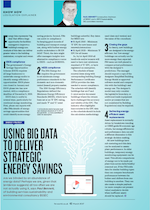Can’t see the wood for the trees? Use Big Data to deliver strategic energy savings.
Introduction
Are we blinded by an abundance of energy data? Perhaps we are, given that (evidence suggests) all too often we are not actually using it.
Energy data represents ‘big data’ and it offers a huge opportunity for facilities management practitioners to deliver major improvements around a building’s energy management strategy. By analysing energy data, facilities managers can deliver greater value to the building maintainer, occupier and owner.
Useful data can be gleaned from a variety of sources, and then applied in a variety of ways. By looking at four of these sources, we can see the opportunities they could deliver.
1. ESOS Compliance
The Government’s Energy Savings Opportunities Scheme (ESOS) requires all large business to undertake energy audits to identify energy efficiency opportunities. ESOS Phase One closed in January 2016 and ESOS Phase Two has now started, with a compliance deadline of December 5, 2019.
ESOS data could prove useful in a number of ways, particularly around ongoing energy monitoring.
First, Phase One reports will offer details of energy savings opportunities that may not have been considered by facilities management which could identify further energy-saving projects. Second, facilities managers can assist re-compliance by keeping good records of on-going building and transport energy use, along with further energy audits undertaken to BS EN 16247. Finally, the data might offer managers with insights about alternative compliance routes to ESOS, such as ISO50001.
2. MEES Compliance
The 2011 Energy Act requires the Government to set minimum energy performance standards in the domestic and non-domestic rented (leased) property market.
The 2015 Energy Efficiency Regulations defined the Minimum Energy Efficiency Standards (MEES) which has been set at an ‘E’ EPC rating, and made ‘F’ and ‘G’ rated buildings unlawful. Key dates relating to the MEES are:
- 01 April 2018 – Minimum ‘E’ EPC for new leases and renewals/extensions
- 01 April 2023 – Minimum ‘E’ EPC for all leases
So, by 1st April 2018 all landlords and/or tenants will need to have met minimum standard of ‘E’ EPC, or have registered an exemption.
The schedule of lease renewal dates along with corresponding building Energy Performance Certificates (EPCs) provides the data needed to assess compliance. The schedule will identify buildings that are F- and G-rated and/or document buildings where the owners have challenged the accuracy and validity of the EPC. The industry often highlights inaccuracies in the EPC data so the schedule should include the calculation methodology used (date and version) and the name of the consultant.
3. Closing Performance Gaps
In theory, newly constructed buildings are designed to be efficient, low energy, promote productivity and occupant health. In reality, these buildings rarely operate well, with common problems manifesting in poor thermal comfort, poor acoustics, poor energy efficiency, troublesome maintenance and complaints by users. It is widely accepted and understood that most ‘low energy’ buildings in fact consume much more energy than they were modelled to do so.
Facilities management teams are well placed to measure actual performance and compare this with the designer’s predictions. The manager should request a copy of the designers Simplified Building Energy Model or approved software model and compare this with the building’s actual energy consumption. The designer’s model may only consider the legislative boundary, so additional loads (such as equipment and/or processes which are not considered by Building Regulations) may be required.
4. Delivering Energy Efficient Asset Replacements
At present, asset replacement is normally driven by breakdown trending or CIBSE guide M economic age criteria but energy efficiencies and performance data can add a different dimension to this strategic decision-making.
All new buildings now have sub-metering and this data can be analysed to assess individual plant performance. In older buildings, temporary energy monitoring equipment can be used to achieve measurements. This allows comparisons of energy consumption to be made per plant item across daily/weekly/seasonal use. If the facilities manager happens to hold data for similar building types then they can make benchmark performance between the boilers and chillers from one building to another. They can also make a simple payback (or more complex net present value) analysis to decide when assets should be replaced in order to ensure efficiency gains.
This article first appeared in FM World, March 2017.







